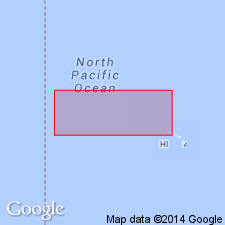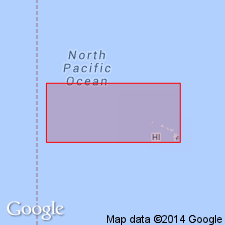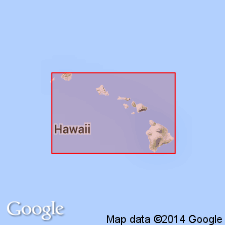
- Usage in publication:
-
- Haiku volcanics*
- Modifications:
-
- Original reference
- Dominant lithology:
-
- Basalt
- Tuff
- AAPG geologic province:
-
- Oahu
Summary:
Haiku volcanics. Basalt and tuff. Composed of nepheline-melilite basalt in dense jointed columns and well-bedded blocky tan lithic tuff. Is as much as 30 feet thick. Included in lower part of Honolulu volcanic series [q.v.]. Unconformably overlies Koolau volcanic series. Underlies calcareous nonmarine and marine sediments. Terraces indicate unit erupted before or during Kaena stand of sea (middle? and late Pleistocene). [Age is considered late Pleistocene.]
Notable exposures in Haiku Valley, along Haiku stream and the coast near its mouth, [Kaneohe 7.5-min quadrangle, Honolulu Co.], Island of Oahu, HI. May occur in upper part of Haiku Valley at 700 feet elevation where basalt is similar microscopically. Named from Haiku stream.
[Additional locality information from USGS GNIS database and USGS historical topographic map collection TopoView, accessed on July 20, 2023. Hawaiian spelling: Haʻikū Valley (U.S. Board on Geographic Names, 2000).]
Source: US geologic names lexicon (USGS Bull. 896, p. 895); GNU records (USGS DDS-6; Menlo GNULEX).

- Usage in publication:
-
- Haiku volcanics*
- Modifications:
-
- Age modified
- AAPG geologic province:
-
- Oahu
Summary:
Pg. 84-85. Haiku volcanics. Lava flows of nepheline basalt containing pegmatoid veinlets and segregations, and associated cinder and palagonite tuff, containing fragments of Koolau lavas. Pyroclastic rocks more than 30 feet thick in places, and lava flow more than 20 feet. Unconformably overlies Koolau volcanic series and underlies noncalcareous nonmarine and marine sediments. Probably erupted during plus 95-foot (Kaena) stand of sea. Pillow-like structures in lava near coast suggest unit entered water. No fossils. Age is considered Pleistocene, based on stratigraphic relations.
Source: US geologic names lexicon (USGS Bull. 1200, p. 1645); supplemental information from GNU records (USGS DDS-6; Menlo GNULEX).

- Usage in publication:
-
- Haiku Volcanics*
- Modifications:
-
- Geochronologic dating
- AAPG geologic province:
-
- Oahu
Summary:
Rb-Sr concentration and Sr isotopic composition for nepheline-melilite basalt from Haiku vent were measured. Results of calculations on 14 basalts indicate that Honolulu Volcanic Series is less than 0.6 Ma.
Source: GNU records (USGS DDS-6; Menlo GNULEX).

- Usage in publication:
-
- Haiku Volcanics†
- Modifications:
-
- Abandoned
- AAPG geologic province:
-
- Oahu
Summary:
Haiku Volcanics (Stearns, IN Stearns and Vaksvik, 1935) abandoned as formally named unit and called Haiku flow (and associated cone), informal unit of Honolulu Volcanics.
Source: GNU records (USGS DDS-6; Menlo GNULEX).
For more information, please contact Nancy Stamm, Geologic Names Committee Secretary.
Asterisk (*) indicates published by U.S. Geological Survey authors.
"No current usage" (†) implies that a name has been abandoned or has fallen into disuse. Former usage and, if known, replacement name given in parentheses ( ).
Slash (/) indicates name conflicts with nomenclatural guidelines (CSN, 1933; ACSN, 1961, 1970; NACSN, 1983, 2005, 2021). May be explained within brackets ([ ]).

